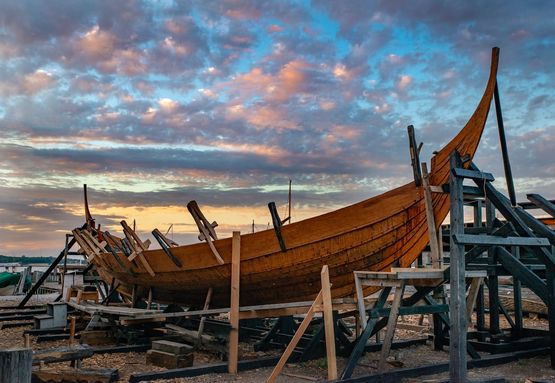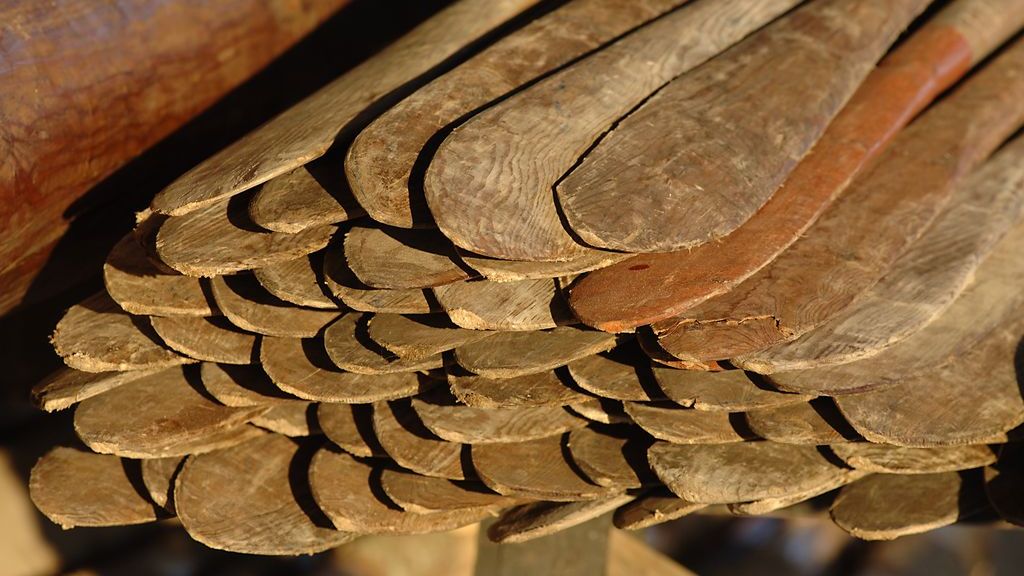The sight of Skuldelev 3’s hull at the boatyard has become a familiar one for visitors to the Museum. Since 2017, the boatbuilders have spent each summer working on the reconstruction of the 14 m long cargo ship and many thousands have followed their progress, both here at the Museum and online.
This season, however, marks the beginning of a new phase for Skuldelev 3, with its launch on Saturday May 7th.
While the construction of the ship may have been five years in the making, it’s actually a project that has roots stretching all the way back to 1982. For this isn’t the first time the Museum has built a full-scale reconstruction of Skuldelev 3.
Roar Ege - from reconstruction to retirement
Our first reconstruction of Skuldelev 3, Roar Ege, was the very first Viking ship built by the Museum. Built from 1982 – 84, Roar Ege’s construction and launch marked the start of a process that would form the core of the Museum’s research endeavours: the experimental archaeological reconstruction of ship and boat finds.
With Roar Ege’s launch in 1984, a seaborne experiment began. A volunteer boat guild was established and systematic sailing and rowing tests were carried out to determine the ship’s sailing abilities. These tests – and the reconstruction process that went before it – drew on the combined expertise of many different specialists, including sailors, boatbuilders and archaeologists.
They also established the Viking Ship Museum as a world leader in the field of maritime experimental archaeological research. The insights gained through test-sailing Roar Ege completely revolutionised our understanding of how Viking ships sailed. Where they had previously been viewed as quite primitive and not particularly effective vessels, Roar Ege and its crew proved that Viking ships could be handled sharply and effectively, cementing the importance of ships and seafaring as the foundation for the events of the Viking Age.
Over the years, however, the many nautical miles Roar Ege sailed began to take their toll on the hull. After 32 years on the water and several phases of extensive repair, it was decided to retire the ship on land in 2016.
A gab in the collection and a new opportunity
Roar Ege’s retirement on land placed us in something of a dilemma. It had long been a principle for the Museum that the five Skuldelev ships on display in the Viking Ship Hall are best understood when we have a full-scale, sailing reconstruction of each of them. Roar Ege’s retirement meant we had a significant gap in that collection.
Building a new reconstruction of Skuldelev 3 would allow us to fill that gap. It would also provide us with a unique research opportunity. Would a re-examination of the original ship-find, with more than thirty years combined experience accumulated while reconstructing the other Skuldelev ships, result in a new interpretation of Skuldelev 3’s form?
In 2017, we decided to find out.
New interpretation and new discoveries to be made
The Museum’s ship reconstructor, Vibeke Bischoff, went back to the drawing board, re-examining the original 1:1 documentation drawings, which were made when Skuldelev 3 was excavated back in 1962. These drawings were then scaled down and used to build a 1:10 model in cardboard. The scaled-drawings were glued onto the cardboard so that each plank became a ship component in miniature, with all details such as the original rivets holes, joints, treenails and so on.
Starting with the keel and stems, Vibeke built the model up the exact same way you would build the ship in full-scale. Each plank was added and fixed in place using the original rivet holes as a guide, ensuring that the form of the hull would be as accurate a reconstruction of Skuldelev 3 as possible. Once the first five strakes were in place, she could begin to add the floor timbers, or ribs of the ship. Piece by piece, the shape of the hull emerged and we could get a sense of how the new interpretation of Skuldelev 3 would look.
The re-examination of the original post-excavation documentation and the process of building a new 1:10 model has resulted in a new interpretation of Skuldelev 3’s hull form and so this new ship is not just a reproduction of Roar Ege. This time, the keel has more rocker – a more rounded curve when you look at the ship side-on – and the hull overall is 12 cm wider amidships.
These may sound like small details when you talk about a 14 m long ship, but the difference to the keel in particular can potentially have a significant impact on how the ship handles. This gives us an opportunity to reassess Skuldelev 3’s sailing capabilities and to gain a better insight into the ship’s original function as a small cargo ship, improving our understanding of trade and transport in the late Viking Age.
A window to the past
It’s not just once it’s on the water that Skuldelev 3 has the potential to enhance our understanding of Viking Age ships. Many new insights have already been gained during the course of the reconstruction process, which shed light on how Viking Age boatbuilders made the most of the materials they had to hand, their approach to symmetry and the deep understanding they had for the craft of ship-building.
Skuldelev 3 as you can see it in the Viking Ship Hall today appears like an extremely elegant ship, with flowing curves and lines that seem to run harmoniously along the hull’s length. But a closer examination reveals small details that can speak volumes about ship-building in the past. Planks that vary in width from port to starboard side, stringers – longitudinal reinforcements inside the hull – with highly uneven edges, knees and futtocks which are anything other than uniform in appearance.
When building Roar Ege, a conscious decision was made to ‘straighten out’ many of these irregularities. Over thirty years later – and with the confidence of three decades of experience with building Viking ship reconstructions - these peculiarities of form are something our boatbuilders have chosen to adhere to in this new Skuldelev 3, as they more accurately represent the decisions the original boatbuilders made almost 1,000 years ago.
It can, however, be something of a challenge for a modern boatbuilder, to accept a less-than-perfect finish. For our boatbuilders, it has given them a new understanding of Skuldelev 3 as a ship-find and a deep respect for the skills and abilities of their Viking Age predecessors. For if you stand and gaze at the new Skuldelev 3 at the boatyard today, it looks just as harmonious and elegant as the original ship in the Viking Ship Hall. But step a little closer, and you begin to notice the small details that reflect design-choices made almost 1,000 years ago – a direct greeting from the past.
Experimental archaeology and intangible cultural heritage - two sides of the same coin
It’s this interplay between archaeological ship-finds and traditional maritime craftwork that underlines how experimental archaeology and intangible cultural heritage are inextricably linked. Archaeologists can excavate and analyse ship-finds, but in order to take our research that step further and build and test full-scale ship reconstructions, we are reliant on the skills of traditional boatbuilders to build them, sailmakers and ropemakers to provide sails and rigging, blacksmiths to make fastenings and skilled sailors to sail them.
Here at the Museum, our boat collection reflects that link between experimental archaeology and intangible cultural heritage. Our harbour contains both Viking ship reconstructions and traditional Nordic clinker-built boats. Maintaining and sailing these many various types of vessels helps to preserve the craft skills and traditions that are essential in order for us to continue exploring the fields of Viking Age ships and seafaring.
Last December, our work in maintaining and preserving these traditions entered a new and exciting phase with UNESCO’s inscription of Nordic Clinker-Boat Traditions on their list of the intangible cultural heritage of humanity. Corona put a stopper to the planned celebrations in December and it is therefore fitting, that we will use the occasion of the launch of Skuldelev 3 to mark UNESCO’s acknowledgement of these traditions and to highlight the connection between experimental archaeology and intangible cultural heritage.
In the water but not quite under sail
While Skuldelev 3 will be launched on May 7th and take its maiden voyage by oar on the waters of the fjord, it will be some weeks before the ship will be fully rigged up and ready to sail.
Our rig master, Sune Krohn, will be working on producing the many ropes for the rigging over the course of the summer and visitors to the Museum will be able to follow this process first-hand on the quayside.
Once the ship is fully rigged up, the next phase of the archaeological experiment can begin. The new reconstruction of Skuldelev 3 will undergo a series of controlled test-sailing in order to establish its sailing capabilities and explore the differences in handling from Roar Ege.
A new boat guild will be established and they will form the crew that will actively maintain and sail with the ship in the years to come. And they have many exciting times ahead as the new reconstruction will be used for sailing-trials with various different types of cargo – everything from barrels of fish to sheep, just as the original Skuldelev 3 would have been used – beginning a new and exciting chapter in our exploration of Viking Age ships and seafaring.
Launch of the new ship:
May 7th 2022:
Come and join us for a day of celebration at the Viking Ship Museum boatyard on Saturday May 7th. The Museum will launch its new Viking ship, a reconstruction of the 11th century cargo vessel, Skuldelev 3, and use the festive occasion to celebrate the inscription of Nordic Clinker Boat Traditions on UNESCO’s intangible cultural heritage list.
Where: The Viking Ship Museum, Vindeboder 12, DK-4000 Roskilde
When: May 7th 2022 at 12:00 - 15:00



